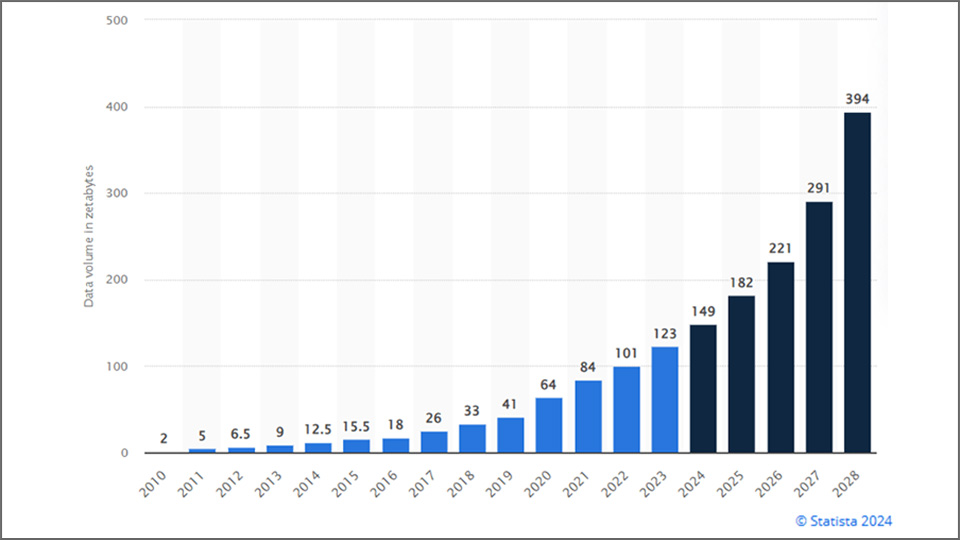Current Estimates And Future Predictions For Global Data Usage And Global Data Storage

The world’s data footprint is astonishingly vast—and accelerating at a staggering pace.
From social media to scientific modeling, streaming entertainment to enterprise analytics, global data creation continues to grow in both volume and velocity. Here’s a closer look at how much data is being generated, how that impacts global data storage, and what the future may hold for managing the ever-expanding digital universe.
Global Data Usage
According to research by Petroc Taylor, 64.2 zettabytes of data were created, captured, copied, and consumed globally in 2020. To put that in perspective, consider a digital copy of the film Blade Runner, which weighs in at approximately 5 gigabytes. At that size, 64.2 zettabytes would be the equivalent of 12.84 trillion copies of the film—enough for every person on Earth to own over 1,600 copies.
Distributing that 64.2 zettabytes evenly across Earth’s 7.8 billion people equates to more than 8 terabytes of data per person. In 2012, that number was closer to 1 terabyte per person, representing a 700–800% increase over eight years, depending on the baseline estimate. The scale of this change reflects a world increasingly driven by digital interactions.
You’ve probably heard the claim that “90% of the world’s data was created in the last two years.” It was a striking headline when first reported over a decade ago, but it no longer reflects the scale or pace of current data growth. In 2022 alone, the world generated more than 100 zettabytes of data, and projections put that number at over 180 zettabytes by 2025. While the exact rate varies by source, most estimates agree: global data volume is doubling every few years—and there’s no indication that trend is slowing.

Data Usage Vs. Data Storage
It’s essential to distinguish between data usage and data storage. While we generate enormous volumes of data, only a small fraction is retained from one year into the next. According to Taylor, approximately 2% of the data created and consumed in 2020 was saved into 2021. Much of what’s produced—streamed content, ephemeral messaging, live sensor feeds—is transient by design.
Storage capacity is growing, but not at the same pace as data usage. Global storage infrastructure has been increasing at a compound annual growth rate (CAGR) of around 19%, compared to roughly 30% CAGR in data creation. This disparity highlights the growing need for more efficient, scalable storage systems, especially as organizations strive to retain and analyze meaningful data.

Video: A Primary Driver Of Data Usage
Among the leading contributors to data growth is video. As of 2022, video accounted for over 80% of global internet traffic and over half of total data traffic worldwide. Streaming services, video conferencing, social media, surveillance systems, and user-generated content are key drivers.
Increasing resolution adds to the pressure. With 4K and 8K now standard for production and 12K and 16K cameras gaining ground, file sizes have ballooned. A single minute of 8K RAW video can consume tens of gigabytes. As quality improves, so too does the burden on storage and networking infrastructure.
For media teams looking to manage the growing volume of high-resolution video files, EVO is a specialized storage solution designed to meet these challenges with ease.

Innovation Beyond Moore’s Law
For decades, Moore’s Law predicted a doubling of transistors—and thus computing power—every two years. But as transistor sizes approach atomic limits, the law has slowed. However, this hasn’t hindered innovation; it has simply shifted direction.
Today’s advancements are less about silicon and more about system-level performance. GPUs enable high-throughput parallel processing for AI, graphics, and video rendering. SSDs and flash storage now use 3D NAND stacking to boost density and speed. But some of the most impactful innovation is happening in software.
From intelligent data tiering to hybrid cloud orchestration, software-defined solutions are transforming how storage is used, managed, and optimized.

Meeting The Challenge With EVO
For media professionals, managing this exponential data growth isn’t a theoretical problem—it’s a daily reality. SNS’ EVO shared storage system is purpose-built to meet these challenges with a balance of performance, scalability, and ease of use.
EVO combines high-speed, multi-user shared storage with an integrated suite of software tools designed for media teams. This includes media asset management, workflow automation, remote editing tools, and advanced security features. Whether editing in Adobe Premiere Pro, DaVinci Resolve, Final Cut Pro, or Avid Media Composer, teams can work collaboratively on massive 4K–16K files with no need to copy media back and forth.
Whether you’re a creative studio, post-production house, or enterprise video team, EVO offers a solution that scales with your needs—today and tomorrow.
The Takeaway
The sheer scale of global data creation is difficult to grasp, yet its implications are undeniable. As we barrel towards a future of even greater digital output, the conversation must shift beyond just “how much data” to “how do we harness its potential?” This means recognizing that efficient data storage is just one piece of the puzzle. The real value comes from robust systems that facilitate seamless access, intelligent management, and impregnable protection.
Nowhere is this more evident than in the media industry, where the pursuit of higher resolutions and more complex projects directly translates to an immense data burden. By providing the tools to effectively store and manage your data, EVO ensures that the ever-expanding digital universe becomes an asset, not an obstacle.
Contact SNS for a demo of the award-winning EVO shared storage hardware solution and its included EVO Suite of software tools.
Sage Syracuse is a Support Engineer at SNS, specializing in translating complex technical concepts into clear, user-friendly language. With a passion for digital preservation, Sage actively works to safeguard lost cultural media using their home server. In their free time, they enjoy bouldering, gaming, and tinkering with technology, including Raspberry Pis and Arduinos.
